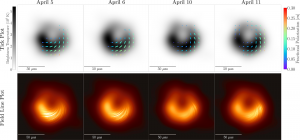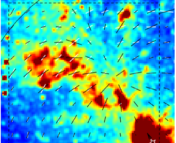Title: First M87 Event Horizon Telescope Results. VIII. Magnetic Field Structure near The Event Horizon
Authors: The Event Horizon Telescope Collaboration
Status: Published in The Astrophysical Journal Letters, open access
In 2019, the Event Horizon Telescope (EHT) Collaboration released the first ever image of a black hole. They used a network of telescopes across the globe and found that the black hole, located 55 million light years away in the M87 galaxy, has a mass that is 6.5 billion times that of the Sun. Their images and measurements took the world by storm, and now the collaboration has released new results based on the polarization near the black hole. The group released two papers this week: the first detailing the polarimetric observations (Paper VII) and the second discussing models of the magnetic field structure of the black hole (Paper VIII).
Scrambled Synchrotron Radiation
The M87 black hole emits radio light because of synchrotron radiation. The material surrounding the black hole is a plasma, and is therefore full of electrons and ions. Those charged particles move close to the speed of light. When they encounter a magnetic field, they spiral around it and release radio waves, which can then be detected by the EHT.
Synchrotron radiation is usually extremely polarized (near 70%), which means that the light is mostly oriented in a single direction. Astronomers can use the polarization of light from a given black hole to trace the magnetic field, since its orientation is perpendicular to the direction of the magnetic field.
In Figure 1, the authors show the EHT polarization measurements for four days of observation. The top row shows the overall intensity in grayscale with the polarization vectors overlaid in color. The length of each vector corresponds to the strength of the polarization, the direction shows the angle of polarization, and the color represents the fractional polarization (how polarized the light is for how much total radiation is emitted in that location). The bottom row shows a ‘smoothed’ version of the polarization vectors overlaid on images of the black hole. Interestingly, only the bottom part of the ring is significantly polarized. It has a maximum fractional polarization near 15%, which is much lower than predicted by synchrotron radiation!

Figure 1. EHT polarization measurements of the M87 black hole. See Figure 7 in Paper VII.
Because of the low polarization, the EHT collaboration proposes that something else must be going on in the material around the black hole: Faraday rotation. In Faraday rotation, the polarization gets scrambled and essentially cancels itself out as the light moves through the magnetized plasma.
A Not So Simple Magnetic Field
While Figure 1 shows the OBSERVED polarization vectors, Figure 2 shows three different models of IDEAL magnetic fields. The top panels show the polarization vectors that would result from a certain magnetic field orientation. The middle panels show the same thing for a different model of the black hole. The bottom panels show three different orientations of the magnetic field in blue and the polarization vectors (which are perpendicular to the magnetic field) in black. First, on the left is a toroidal field. The magnetic field moves in a circle, swirling around the black hole shadow at the center. The middle column shows the same for a magnetic field that propagates radially out from the black hole. The right column shows a more complex scenario: the magnetic field runs along the line of sight to the black hole. The twisting pattern in the polarization vectors comes from light bending and relativistic motion.

Figure 2. Ideal magnetic field scenarios near the black hole. The bottom row shows the orientation of the magnetic field and the top/middle rows show the resultant polarization vectors. See Figure 3 in Paper VIII.
The authors of these papers do A LOT of work to model the magnetic field in the region around the black hole. However, they do not find just one model that fits their polarization measurements. Instead, they find that the best models predict magnetic fields that are either radial, vertical, or some combination of the two. And, with even more polarization measurements taken in higher frequencies, the authors argue that they will be able to constrain the magnetic field even further.
Polarimetric measurements like these provide constraints not only on the magnetic field, but also on things like how much mass the black hole is accreting and the power of its jet. By comparing observations to models, astronomers will continue to unlock the structure and secrets of black holes.
Astrobite edited by Alice Curtin
Featured Image: EHT Collaboration




